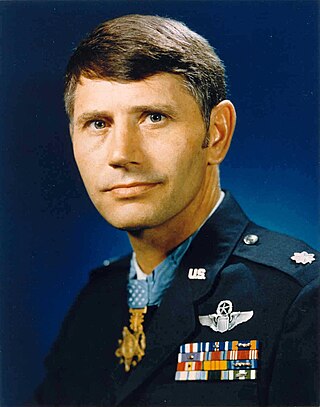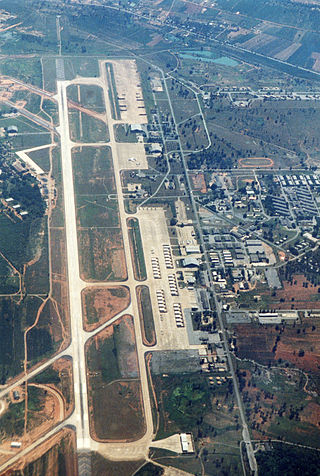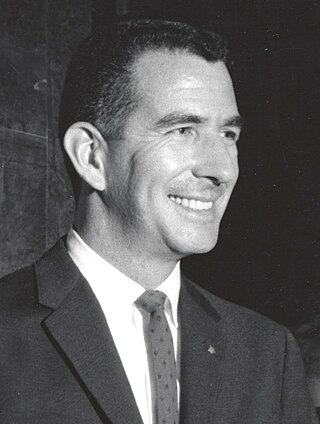
The AGM-88 HARM is a tactical, air-to-surface anti-radiation missile designed to home in on electronic transmissions coming from surface-to-air radar systems. It was originally developed by Texas Instruments as a replacement for the AGM-45 Shrike and AGM-78 Standard ARM system. Production was later taken over by Raytheon Corporation when it purchased the defense production business of Texas Instruments.

Operation Rolling Thunder was a gradual and sustained aerial bombardment campaign conducted by the United States (U.S.) 2nd Air Division, U.S. Navy, and Republic of Vietnam Air Force (RVNAF) against North Vietnam, China and North Korea from 2 March 1965 until 2 November 1968, during the Vietnam War.

The Grumman A-6 Intruder is an American twinjet all-weather attack aircraft developed and manufactured by American aircraft company Grumman Aerospace and formerly operated by the U.S. Navy and U.S. Marine Corps.

The Republic F-105 Thunderchief is an American fighter-bomber that served with the United States Air Force from 1958 to 1984. Capable of Mach 2, it conducted the majority of strike bombing missions during the early years of the Vietnam War. It was originally designed as a single-seat, nuclear-attack aircraft; a two-seat Wild Weasel version was later developed for the specialized Suppression of Enemy Air Defenses (SEAD) role against surface-to-air missile sites. The F-105 was commonly known as the "Thud" by its crews. It is the only American aircraft to have been removed from combat due to high loss rates.

The LTV A-7 Corsair II is an American carrier-capable subsonic light attack aircraft designed and manufactured by Ling-Temco-Vought (LTV).

Wild Weasel is a code name given by the United States Air Force (USAF) to an aircraft of any type equipped with anti-radiation missiles and tasked with the suppression of enemy air defenses (SEAD): destroying the radar and surface-to-air missile (SAM) installations of enemy air defense systems. The task of a Wild Weasel aircraft is to bait enemy anti-aircraft defenses into targeting it with their radars, whereupon the radar waves are traced back to their source, allowing the Weasel or its teammates to precisely target it for destruction.

Suppression of Enemy Air Defenses (SEAD, pronounced ), also known in the United States as "Wild Weasel" and (initially) "Iron Hand" operations, are military actions to suppress enemy surface-based air defenses, including not only surface-to-air missiles (SAMs) and anti-aircraft artillery (AAA) but also interrelated systems such as early-warning radar and command, control and communication (C3) functions, while also marking other targets to be destroyed by an air strike. Suppression can be accomplished both by physically destroying the systems or by disrupting and deceiving them through electronic warfare. In modern warfare, SEAD missions can constitute as much as 30% of all sorties launched in the first week of combat and continue at a reduced rate through the rest of a campaign. One quarter of American combat sorties in recent conflicts have been SEAD missions. Despite generally being associated with aircraft, SEAD missions may be performed using any means, including through actions by ground forces.

An anti-radiation missile (ARM) is a missile designed to detect and home in on an enemy radio emission source. Typically, these are designed for use against an enemy radar, although jammers and even radios used for communications can also be targeted in this manner.

AGM-45 Shrike is an American anti-radiation missile designed to home in on hostile anti-aircraft radar. The Shrike was developed by the Naval Weapons Center at China Lake in 1963 by mating a seeker head to the rocket body of an AIM-7 Sparrow. It was phased out by U.S. in 1992 and at an unknown time by the Israeli Air Force, and has been superseded by the AGM-88 HARM missile. The Israel Defense Forces developed a version of the Shrike that could be ground-launched with a booster rocket, and mounted it on an M4 Sherman chassis as the Kilshon.

The AGM-76 Falcon was an air-to-surface anti-radiation missile developed by the United States Air Force during the Vietnam War. Intended as a conversion using off-the-shelf parts, it did not go into operational service.

The AGM-78 Standard ARM or STARM was an anti-radiation missile developed by General Dynamics, United States. It was built on the airframe of the RIM-66 Standard surface-to-air missile, resulting in a very large weapon with considerable range, allowing it to attack targets as much as 50 miles (80 km) away.

Leo Keith Thorsness was a colonel in the United States Air Force who received the Medal of Honor for his actions in the Vietnam War. He was awarded the medal for an air engagement on April 19, 1967. He was shot down two weeks later and spent almost six years in captivity in North Vietnam as a prisoner of war. After his military service, Thorsness served one term in the Washington State Senate.

The S-75 is a Soviet-designed, high-altitude air defence system. It is built around a surface-to-air missile with command guidance. Following its first deployment in 1957 it became one of the most widely deployed air defence systems in history. It scored the first destruction of an enemy aircraft by a surface-to-air missile, with the shooting down of a Taiwanese Martin RB-57D Canberra over China on 7 October 1959 that was hit by a salvo of three V-750 (1D) missiles at an altitude of 20 km (66,000 ft). This success was credited to Chinese fighter aircraft at the time to keep the S-75 program secret.

Korat Royal Thai Air Force Base is a base of the Royal Thai Air Force (RTAF) in northeast Thailand, approximately 200 km (125 mi) northeast of Bangkok and about 4 km (2.5 mi) south of the centre of the city of Nakhon Ratchasima in the Nakhon Ratchasima Province, the largest province in Thailand.

Takhli Royal Thai Air Force Base is a Royal Thai Air Force (RTAF) facility in central Thailand, approximately 144 miles (240 km) northwest of Bangkok in Takhli District, Nakhon Sawan Province.

The Package Q Airstrike was the largest airstrike of the Gulf War and the largest strike of F-16 Fighting Falcon fighter aircraft in military history. Many aircraft, including the F-117 Nighthawk, were used to attack targets in Baghdad, which was the most heavily defended area of Iraq. The same target was hit several times by F-117s, and the last package consisted of seventeen F-111F Aardvarks on the 19th day of the war.
"Dancing with Death" was the satirical term used by US Air Force combat pilots to describe evasive maneuvering while facing advanced Soviet surface-to-air missiles (SAMs) over Vietnam.

During January 1993, numerous coalition airstrikes occurred against Iraq in response to actions by the latter predominantly due to the No-Fly Zone in Southern Iraq.

Kevin Alfred Gilroy was a United States Air Force (USAF) colonel and was one of the most highly decorated Electronic Warfare Officers in the USAF. After his retirement from the Air Force, he served as the mayor of the city of Gilroy.

















